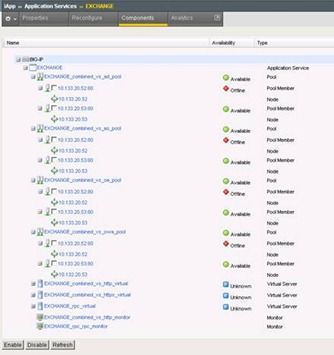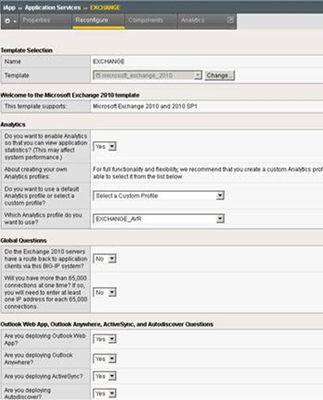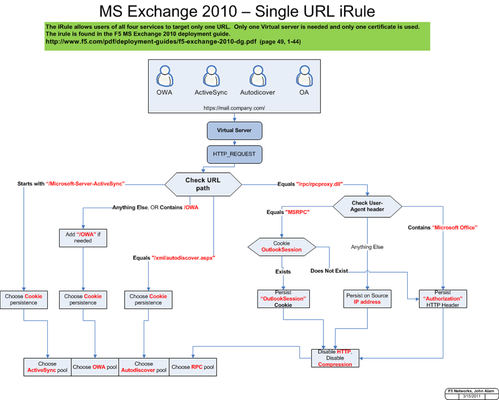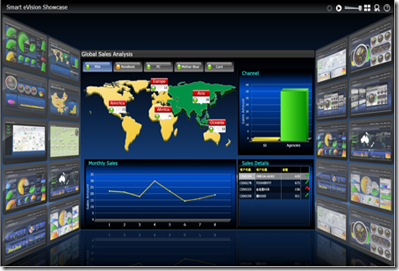exchange 2010
5 TopicsMigrating from Exchange 2007 to 2010 with Access Policy Manager
When it comes to upgrades, implementations, migrations, etc., you can plan for months. You can test, test, and then test some more. You can cross every “i” and dot every “t”. But at the end of the day, it all comes down to the end-user experience. Making the transition from one platform to another is as seamless as possible for your users is crucial. When it comes to migrating from Exchange 2003/2007 to Exchange 2010, The Big-IP platform with Access Policy Manager, (APM) can help do just that; make the end-user experience as seamless as possible. For many organizations, migrating from previous versions of Exchange to Exchange 2010 is not a simple “flip of the switch”. Rather, multiple versions must co-exist as users are gradually migrated over to the new platform. In the video below, we’ll take a look at the Big-IP Exchange solution and how it can be easily modified to provide single sign-on access to the user regardless of which version hosts their mailbox. So check it out and remember; happy users equals a happy migration. Note: This video assumes a general administrative knowledge of the BIG-IP Local Traffic Manager LTM module and familiarity with the Big-IP APM.173Views0likes0CommentsiApp–Full Application Lifecycle Management
iApp certainly can do a lot for an organization by allowing them to optimize their network in a matter of minutes, but they also provide full application lifecycle management as well. The user can make changes to their configuration simply by opening the application service instance previously created by the iApp template and make the necessary edits. The user interface is exactly the same as they used to originally deploy the application. Why is that so important? Context. ADCs are part of the core network infrastructure and are used to optimize the delivery of multiple mission critical applications at the same time. Think of how many applications a single organization has and you will understand why the median number of virtual servers per device is thirty and pools around twenty. That’s already over fifty objects and we haven’t even talked about monitors, profiles, iRules and policies. When those objects are organized by type, rather than by relation, day to day management, troubleshooting and even reporting becomes very difficult. iApp puts objects into context. In the components view, the user is presented with a hierarchical display of objects related to that application instance. The health status of an object is also displayed giving the user a quick visual reference of the application’s overall health. This quick inspection is useful in identifying which application component is having trouble, focusing troubleshooting efforts and inevitably resulting in faster resolution. The components view also provides the user with speedy access to enable or disable a single or multiple instances or application resource. This management task is commonly performed during server maintenance windows. An instance is disabled to redirect connections to other resources so an administrator can apply a hot fix or application upgrade without impacting end-users. Once complete and the instance is ready to receive connections, the administrator simply enables the node. This scenario accounts for nearly twenty five percent of the user’s interaction with the device, but without context, determining which instances apply to which application can be difficult and time consuming. And finally, an analytics view is available to provide the user with key metrics for capacity planning, troubleshooting, performance, as well as ROI reporting. A large number of statistics can be collected and viewed at a granular level of the user’s choice.196Views0likes0CommentsiApp–Benefits
So let’s start today by looking at some of the key features of iApp using the F5 Exchange 2010 template as an example. A user would select a template they wished to use from a drop down field in the user interface. Once selected, they will be presented with the questions and input fields defined by the iApp author. It looks like this…… F5-provided iApp templates all have key features that help bridge that IT knowledge gap I spoke about previously. Goal-based configuration - Goal-based questions are used to translate industry jargon into terms more appropriate to the end-user’s goal. An example of this is when we refer to a specific servers IP address, rather than calling it a node (an F5-specific term). Application specific - We use vendor referenced names, such as autodiscover and ActiveSync(tm) that enable the network team to speak the application team’s language to get more accurate and faster results. Inline help - Inline help is also added where needed to give additional information to help the user make the appropriate choice for their environment or to notify them of any related impact to system performance or security. Dynamic questions - F5-provided iApps allow the user to determine which application roles apply to their environment and only show the questions necessary for configuring those services. F5 module aware - Templates will ask you if you wish to provide acceleration and/or security services for your application based on licensed F5 modules. All these features enable IT network and application teams to bridge the knowledge and language gap to extract application knowledge that is unique to their environment. This significantly improves the accuracy and speed of their deployment. One possible side effect might just be the network and application folks getting along a little better. I am not talking about IT world peace, but maybe a marked reduction in finger pointing and frustration. Or perhaps even a friendly, “Hello, how are you doing?” at the coffee machine. If you don’t believe that can happen yet, let me show you one other major benefit of F5-provided iApp templates. Remember when I said in the last paragraph, “application knowledge that is unique to their environment?” That’s because anything that is not unique to the environment is auto configured for the user! We have taken our years of hands-on experience with applications and our business partners to develop configuration that optimizes the network for mission critical applications in a matter of minutes. Using our Exchange example that means nearly 90% of the configuration is done for you, and not only is your network optimized for high availability, but security and acceleration too. That means a huge reduction in time spent readying your network for your application and as well as chances for misconfigurations. *game changing*264Views0likes0CommentsMicrosoft Exchange 2010 iRule Workflow Visualized
F5’s own John Alam sent over his latest Visio creation to share with the DevCentral community. This diagram details the workflow of the comprehensive exchange services iRule described in the Microsoft Exchange 2010 Deployment Guide. Enjoy. For visio, pdf, png, & svg versions of this image, click here. Related Articles Microsoft Exchange 2010: HELO New Architecture Webcast - Microsoft Exchange Server Availability And Scalability Exchange Persistence Duality and iRules > DevCentral > F5 ... How Microsoft deployed Exchange Server 2010 with hardware load ... Planning an Exchange Migration? - DevCentral - F5 DevCentral ... Exchange 2010 with F5 BIG-IP and Dell Article Published devconnections 2010: Attendee discusses Exchange and Cloud Computing F5 with mixed Exchange 2007 and 2010 Client Access Servers ... Trying to implement Exchange 2010 - DevCentral - F5 DevCentral ... Exchange 2010 Monitors for LTM - DevCentral - F5 DevCentral ... Exchange 2010/LTM10.2 RPC mail delivery delay ? - DevCentral - F5 ... Exchange 2010 Global address list issue - DevCentral - F5 ... F5 solution for Microsoft Exchange DevCentral Weekly Roundup | Audio Podcast - Exchange Exchange 2007 - What Type of SSL certificate required (single ...247Views0likes0CommentsLive from Microsoft Tech Ed: Final Day
So I guess I’m on the even days plan here at Tech Ed, today being the fourth and final day of Tech Ed… Yesterday I got the chance to walk around the exhibitor hall and collect swag take a look at the exciting offerings on the floor. Microsoft had three very large sections with breakout booths for all their product offerings. I stopped and chatted with a few experts in the Server 2008 R2 virtualization offerings, and watched a couple System Center demos as well. Speaking of System Center, did you know F5 has a management pack for System Center? I talked to several booth visitors yesterday who own System Center and F5 BIG-IP that had no idea…they left the booth pretty excited. I also talked to some Exchange 2010 guys about the and they spoke very highly on our solution. Do you like free? I walked by the NetWrix booth and 10 Free Tools for IT Professionals screamed out to me. See, I’m a cheapskate and I really like free things—as long as they bring value. I’ve written some basic powershell scripts to do the work of some of these tools, but they look like a nice set to add to your toolbox. Several of them have additional features at cost if it makes sense in your environment. Need some serious eye-candy for your operations center, leadership team or for demos? The dashboards (particularly the 3D Cockpit at left) are most impressive. Smart eVision offers a three month free online trial if you are interested. I didn’t win this Ducati motorcycle that SunBelt Software gave away. I suppose that’s ok since a) I was given the ticket, b) I don’t have a motorcycle license, and c) I doubt I could talk my wife into letting me have one anyway. Still, that would have been turned into a nice cash prize. Oh well. I can still leave Tech Ed, and New Orleans, a little bit wiser in the ways of several of Microsoft’s technologies. I can also thank Ryan for taking me to school on the many ways our own F5 technologies plug in to the Microsoft solutions, enabling them to scale and improving their performance. Agility indeed.219Views0likes0Comments



